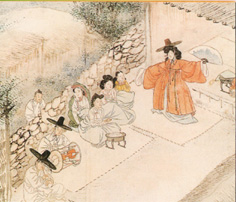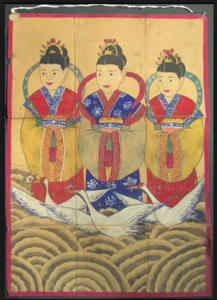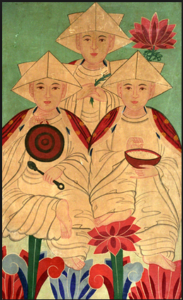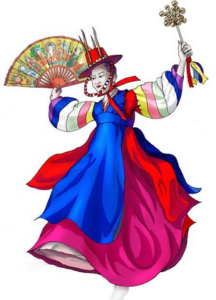publicly demeaned, where their symbolic value is reduced by strong Confucian ideology, the female mansin’s cross-dressing becomes complex and multi-functional.
In semiotic terms, the costume is an icon for the person or the spirit it represents. The mansin in the costume assumes the role of that icon, thereby becoming a female signifying a male; she is a cross-sex icon about 75% of the time during a typical kut. In the context of the kut, the mansin is a sexually liminal being; by signifying a man, she not only has access to the male authority in the Confucian order, she provides the female audience an opportunity to interact with that authority in ways that would, in a public context, be unthinkable. Her performance is often a parody of the male authority figures; she often makes off-color jokes and ribald comments, and argues with the audience. During one of the colorful moments of the chaesu kut held for the 1985 Summer Seminar, Yongsu’s Mother, as the Taegam spirit, held a folded fan between her legs as if it were a huge penis and jerked it back and forth at us as she made a series of lewd expressions much to the amusement of the Koreans (and to the shock of some of the Americans). She ridiculed the men present by comparing their penises to her little finger which she peered at as if it were microscopic. The mansin turned the Confucian elevation of maleness (the penis) and public power (what the penis signifies) into a joke, suggesting that she, a lower-class woman, could have a larger penis (more power) than the men in the room (including the Fulbright Director, who in Confucian terms, wielded substantial power); but at the same time, this enactment emphasized the importance of the very thing it parodied.
Later, while she played the chango drum and the Second mansin became possessed by her husband’s spirit, Yongsu’s mother insulted him, chastised him for having been a poor provider while he was alive, and told him the cigarette she was smoking was her real husband. This incident and the once described above indirectly address an issue that has yet to be adequately studied by anthropologists: Shamanism as a response to sexual repression.
Lee (1981:182-85) sees repression, particularly sexual repression, as the prime factor in the development of shamans, but his analysis of sexual themes in shaman dreams is incomplete and does not attempt to examine the sexual habits of shamans. All his case studies and most of Harvey’s (1979) indicate that at some point in their lives (usually during and after their possession sickness), the female shamans found sexual intercourse with their husbands repulsive or intolerable; most, by that time, had already borne children. Covell (1983) who writes “keeping the tourist-layman market in mind” (Heymann 1984:48) goes as far as to say that “from stories told by Korean men, their idea of sexual satisfaction is the male orgasm, with very little emphasis on the wishes of the partner.” Covell even parallels sexual repression in Korean society with the Arctic Madness of Siberia as the primary causal factors for Shamanism. His assertions are grossly simplistic and remain unsupported in his work, but he does explicitly address the issue of Shamanism and sexual relations. There are documented cases of homosexuality and homosexual tendencies in male shamans (Lee 1981), but no one has thus far studied the sexuality of female shamans. The dialogue between the Second mansin and Yongsu’s Mother presented an interesting symbolism because the Second mansin, whose relationship with Yongsu’s Mother was quite close, was speaking as her husband — i.e., the husband icon was a woman. Mansin can be considered what was formerly termed, in archaic anthropological diction, “secondary deviants,” but one wonders if Shamanism has also functioned as a culturally acceptable social niche in Korea for persons, who in a contemporary Western context, might typically be classed as homosexuals and lesbians.
Another important aspect of the cross-dressing, in semiotic terms, is that in becoming a male icon, the female is not only masculinized, but the male icon is feminized. This distinction may seem moot at first glance, since the two seem to be essentially the same thing, but the double-edged signification of the mansin possessed by male spirits, given the Confucian hierarchy of male above female and the Taoist placement of yang above yin (um), is quite profound. In the first instance, the woman, by signifying man, gains access to male power and authority; in the second, the authority of the male icon is demeaned by expression in a female medium. The difference is as great as that between a phallic woman and an emasculated (or castrated) man in psychoanalytic terms.
The mansin is not the only one given this access to cross-dressing during a kut. When the women participants make their offerings and dance in the shaman’s clothes (mugam), they, too, become double-edged signifiers. They can become men and dance (the Koreans often use the term nolda — “to play”) to exhaustion; they emasculate the male icon and masculinize themselves as much as they are able, achieving a double catharsis. In dancing in the mugam (usually a Yi Dynasty general’s outfit) they are both controlling and being controlled by the oppressor in the presence of enthusiastic, supportive women and a few uneasy, embarrassed men. (6)




